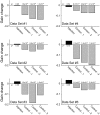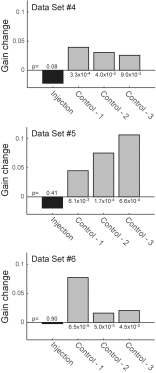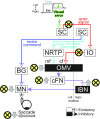Elimination of the error signal in the superior colliculus impairs saccade motor learning
- PMID: 30185563
- PMCID: PMC6156644
- DOI: 10.1073/pnas.1806215115
Elimination of the error signal in the superior colliculus impairs saccade motor learning
Abstract
When movements become dysmetric, the resultant motor error induces a plastic change in the cerebellum to correct the movement, i.e., motor adaptation. Current evidence suggests that the error signal to the cerebellum is delivered by complex spikes originating in the inferior olive (IO). To prove a causal link between the IO error signal and motor adaptation, several studies blocked the IO, which, unfortunately, affected not only the adaptation but also the movement itself. We avoided this confound by inactivating the source of an error signal to the IO. Several studies implicate the superior colliculus (SC) as the source of the error signal to the IO for saccade adaptation. When we inactivated the SC, the metrics of the saccade to be adapted were unchanged, but saccade adaptation was impaired. Thus, an intact rostral SC is necessary for saccade adaptation. Our data provide experimental evidence for the cerebellar learning theory that requires an error signal to drive motor adaptation.
Keywords: cerebellum; error signal; motor learning; saccade; superior colliculus.
Copyright © 2018 the Author(s). Published by PNAS.
Conflict of interest statement
The authors declare no conflict of interest.
Figures








Similar articles
-
How cerebellar motor learning keeps saccades accurate.J Neurophysiol. 2019 Jun 1;121(6):2153-2162. doi: 10.1152/jn.00781.2018. Epub 2019 Apr 17. J Neurophysiol. 2019. PMID: 30995136 Free PMC article. Review.
-
Complex spike activity signals the direction and size of dysmetric saccade errors.Prog Brain Res. 2008;171:153-9. doi: 10.1016/S0079-6123(08)00620-1. Prog Brain Res. 2008. PMID: 18718294
-
A neuronal process for adaptive control of primate saccadic system.Prog Brain Res. 2019;249:169-181. doi: 10.1016/bs.pbr.2019.03.029. Epub 2019 Apr 13. Prog Brain Res. 2019. PMID: 31325976
-
Short-term adaptation of electrically induced saccades in monkey superior colliculus.J Neurophysiol. 1996 Sep;76(3):1744-58. doi: 10.1152/jn.1996.76.3.1744. J Neurophysiol. 1996. PMID: 8890289
-
Saccade adaptation as a model of learning in voluntary movements.Exp Brain Res. 2010 Jul;204(2):145-62. doi: 10.1007/s00221-010-2314-3. Epub 2010 Jun 11. Exp Brain Res. 2010. PMID: 20544185 Review.
Cited by
-
Interaction of dynamic error signals in saccade adaptation.J Neurophysiol. 2023 Mar 1;129(3):717-732. doi: 10.1152/jn.00419.2022. Epub 2023 Feb 15. J Neurophysiol. 2023. PMID: 36791071 Free PMC article.
-
Head impulse compensatory saccades: Visual dependence is most evident in bilateral vestibular loss.PLoS One. 2020 Jan 15;15(1):e0227406. doi: 10.1371/journal.pone.0227406. eCollection 2020. PLoS One. 2020. PMID: 31940394 Free PMC article. Clinical Trial.
-
An implicit memory of errors limits human sensorimotor adaptation.Nat Hum Behav. 2021 Jul;5(7):920-934. doi: 10.1038/s41562-020-01036-x. Epub 2021 Feb 4. Nat Hum Behav. 2021. PMID: 33542527 Free PMC article.
-
Transcranial temporal interference stimulation precisely targets deep brain regions to regulate eye movements.Neurosci Bull. 2025 Aug;41(8):1390-1402. doi: 10.1007/s12264-025-01387-3. Epub 2025 Apr 11. Neurosci Bull. 2025. PMID: 40214945 Free PMC article.
-
Dual STDP processes at Purkinje cells contribute to distinct improvements in accuracy and speed of saccadic eye movements.PLoS Comput Biol. 2022 Oct 4;18(10):e1010564. doi: 10.1371/journal.pcbi.1010564. eCollection 2022 Oct. PLoS Comput Biol. 2022. PMID: 36194625 Free PMC article.
References
-
- Albus JS. A theory of cerebellar function. Math Biosci. 1971;10:25–61.
-
- Ito M. Bases and implications of learning in the cerebellum—Adaptive control and internal model mechanism. Prog Brain Res. 2005;148:95–109. - PubMed
-
- Demer JL, Robinson DA. Effects of reversible lesions and stimulation of olivocerebellar system on vestibuloocular reflex plasticity. J Neurophysiol. 1982;47:1084–1107. - PubMed
-
- de’Sperati C, Lopiano L, Montarolo PG. Lesions of the inferior olive do not affect long- or short-term habituation of the acoustic startle response in rats. Neurosci Lett. 1989;100:164–168. - PubMed
Publication types
MeSH terms
Substances
Grants and funding
LinkOut - more resources
Full Text Sources
Other Literature Sources

